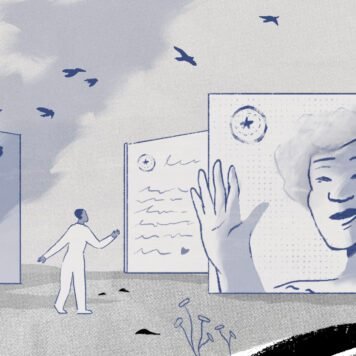In 1998, a trailer for a new psychological drama premiered, posing the question: ‘what if you were watched every moment of your life?’ At the time, a film which surveyed the mundane lives of others was noteworthy, and therefore the plot for the (then) dystopian The Truman Show was born.
Watching The Truman Show over two decades later, I thought about the carefully curated, ad-filled life of Truman Burbank and reflected on todays’ relentless marketing tactics which are tailor-made, targeted and weaved into our lives via multiple types of media. Like Truman, we want to believe we have agency over our decisions (online and offline) but often we’re subjected to influences we are not always consciously aware of.
Instead of a producer, we have algorithms; conveniently placing items to steer our attention and provoke endless buying. Today we are overwhelmed by consumer choices, leading us to confuse the ‘unlimited options’ advertised with a ‘freedom’ to decide. Even the subtle adverts we scroll past have an influence over what we buy and how we buy it.
As we spend more time online, we must consider how we are being manipulated by huge corporations, urging us to give more money to their CEOs.
How are we digitally stalked by artificial intelligence and influenced into a cycle of wanting and buying? Who is watching us? What do they do with our data? How is our consumer behaviour influenced?
When there’s nothing left to sell – we become the products being sold
The concept of people as products isn’t new. In 1975, consumer psychologist Richard Bagoozi introduced the notion of marketing as an exchange process. Traditionally, marketing has exchanged money for goods. Bagoozi however, puts forward the idea that marketing can also exchange other non-physical currencies such as information or specific actions.
For example, you might vote for a candidate (an action) in exchange for a promise (information) that the candidate will commit to their message as marketed. Today this transaction is echoed as the exchange between humans and technology; the acceptance of data collection as part of the online experience.
Making a commodity of our online habits, social media companies have notoriously boosted their revenue by selling us – as data. We are the products that drive huge profits for multinational corporations, reduced to a catalogue of numbers and used to hyper-target marketing.
As a result, you’ve probably noticed the same advert, following you across the web, popping up all over your timelines, feeds and mailboxes. The algorithm (process which arranges data) seamlessly blends product marketing into our digital lives, sometimes subtle and unnoticed – that can unconsciously prompt impulsive buying.
Considered as a mass of ‘consumers’ or ‘users’, we exchange our data for the use of free services such as Instagram or Facebook. By agreeing to ‘cookies’ and the T&Cs of account creation, we are mostly giving permission for platforms (in this case, Meta owns them both) to track our activity, use and share our data.
Tracking occurs as we read or watch; we’re even tracked through who we engage with, our location or other online habits. Through AI filters, the platform analyses our data and builds a user profile – helping to target us with ads and content that we’re more likely to interact with.
The darker side of data collection
The commodification of our personal data has dramatically changed the way we engage with advertisements in the digital space. Switching from traditional print and audio-visual marketing to the real-time format of the Internet has not only impacted how we discover new products, but also how we search for and interact with them.
In 2021, it was estimated that the average person consumed between 6,000 to 10,000 ads each day (with a growing proportion coming from influencer marketing). The ‘influencer’ is not new to marketing. However, the concept of ‘influencing’ has boomed since the early 2010s. This incorporation of ad into the digital lifestyles of influencers make it harder for some to distinguish paid advertisement from real life.
More than a dance app
Not to be dismissed as simply a platform for dancing teens, TikTok is the unexpected powerhouse of modern marketing.
Unlike older social media platforms, TikTok has made it much more attainable to become an influencer. Hosting over 1 billion active users, the Chinese tech company has access to a pool of global data enabling its content to reach viral levels in short periods of time. The most downloaded app of 2021, the platform backdropped the innovative creativity of young people during a time of crisis.
TikTok describes its retail path to purchase (user engagement with products) as an ‘infinite loop’ with no start or end. Stating that the traditional ‘linear’ consumer paths to purchase have been replaced; consumers now discover, consider, review, participate, purchase and then repeat.
According to TikTok, its users spend 14% more when TikTok is part of the purchase journey. It’s therefore understandable why retailers are aggressively investing into TikTok marketing as its strong user engagement and reach are trapping us into its infinite loop of spending.
A recent post by The Sustainable Fashion Forum, highlighted an attitude-behaviour gap between consumer’ sustainability intentions and actions. Despite growing demands for ethically and environmentally sound products, we are still influenced to buy every new and viral product on TikTok. Prioritising instant gratification, our impulsive purchase decisions can override our concerns for sustainability.
The frictionless journey from TikTok feed to shopping cart is accompanied by a surge of emotions. According to Fashion psychologist Shakaila Forbes-Bell, there are six reasons why people buy; to express ourselves, because of persuasive marketing, to showcase our allegiances, because of our insecurities, to belong and to feel good about ourselves.
While we already broadcast much of our own lives, the privacy regarding who is watching us and the protection of our data may not be a high concern. It is easy to focus on what we can consume, rather than what is consuming us. Online, we are actively searching and consuming content, filling our heads with new information, wants and comparisons.
Subscribe to shado's weekly newsletter
Exclusive event news, job and creative opportunities, first access to tickets and – just in case you missed them – our picks of the week, from inside shado and out.

Our decisions to buy or to not to buy particular items can be influenced by the algorithm created for us and the paid marketing that demands our attention. By trying to engineer and predict our thoughts, social media has replaced the random and chaotic marketing that we’d experience by chance. The digital marketing that we consume is designed for us, intended to create urgency and optimise purchases.
To challenge and change our consumption habits, we must also address the increasingly materialistic and individualistic lifestyles that are rewarded and perpetuated online.
The real-life implications of over-consumption is adding to climate breakdown; exhausting finite resources, polluting environments and harming the people responsible for making our endless cycle of clothes, gadgets and other latest trends.
Resistance to consumption
We are not passive participants in the online space, without the ability to resist or respond actively to what we consume. We must remind ourselves that we are ‘citizens’ who partake in democracy (both online and in real life) rather than ‘consumers’ surrendered to the powers of tech giants who harvest our data. To build healthier and more harmonious relationships with technology, we should understand it as a tool to improve our lives – not to dictate it.
I invite you to take charge; to live an intentional online life, where your clicks can act as a form of resistance. We can decide to process and digest the content we are presented with by challenging its reliability and purpose, to question why and how it is marketed to us. It’s only through rejecting the accelerated and disposable nature of the Internet, that we find agency and take control over our online interactions.
What can you do?
- Watch Algorithmic Bias by Tazin Khan
- Consider taking time offline to reconnect with nature and human relationships outside the digital space. Most devices also allow you to set time restrictions on apps and night mode settings.
- Read The Shame Machine: Who Profits in the New Age of Humiliation by Cathy O’Neil
- Read Platform Socialism: How to Reclaim our Digital Future from Big Tech by James Muldoon
- Read TikTok: Trojan Stallion by Scott Galloway
- Read TikTok A Key Part Of Consumers’ Path To Purchase by Matt G. Southern
- Read The infinite loop: TikTok’s unique retail path to purchase
- Read How the IDF is turning TikTok into its latest propaganda tool









